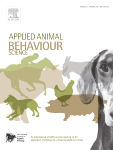Document type: scientific article published in Applied Animal Behaviour Science
Authors: Léa Lansade, Julie Lemarchand, Fabrice Reigner, Cécile Arnould, Aline Bertin
Preview: In mammals, positive tactile contact is recognized as an effective tool for triggering positive affective states. In this study, we investigated the benefits of providing automatic rotative brushes for group-housed horses. Our three aims were: i. to determine whether horses used automatic brushes and if so how they used them; ii. to investigate whether the presence of these brushes induced positive social behaviors (allogrooming), or aggressiveness, as can be observed when there is competition for a desired resource; iii to provide a preliminary explanation of the role of the positive facial expression displayed by some horses while being groomed. Two brushes were installed in a large stable with free access to a paddock in which 40 horses were housed 7h30/day. For four days, video-cameras placed above the brushes continuously filmed the horses. First, analysis of the video footage demonstrated that brushes were used by almost 90% of the horses, mainly on areas that are not easily accessible to another horse during allogrooming, such as the head. Secondly, it revealed that among the horses that used the brush, 25.7% expressed positive social behavior (allogrooming) at the same time, while none expressed aggressive behaviors. The brush thus seems to act as a catalyst for affiliative behaviors rather than competition for a desired resource. Thirdly, we observed their facial expression, especially a positive one, described when the horse are groomed (neck moderately raised, eyes open or half-closed, upper lip extended, ears turned backwards almost in line with the nose). More than half of the horses displayed this while using the brushes. Interestingly, when a horse expressed this face, it had a six times greater chance to subsequently start allogrooming with a conspecific. Several possible explanations are discussed, including a social function. Further research is needed to validate other criteria to help qualify whether or not this positive facial expression is a signal of intentional communication. From a practical point of view, the results show that the brushes provide both a direct benefit to the horses enabling them to conduct self-grooming, and also in all likelihood, an indirect benefit by facilitating positive social interactions. This study encourages the installation of automatic brushes in places where horses are kept to improve their welfare and provide comfort.






